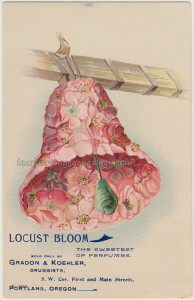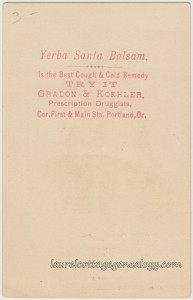Size: About 5 and 1/2 x 3 and 1/2″ Year: Circa 1893 – ? (possibly through 1910s to early ’20s)
Availability status: SOLD
“Locust Bloom. The sweetest of perfumes. Sold only by Gradon & Koehler, Druggists, S. W. Cor. First and Main Streets, Portland, Oregon. A logo of the letter B inside a diamond shape appears at the bottom left of the card; next to this appears what looks like the number 994. This is likely the printer or publisher info.
Printed or stamped on the back of the card is, “Yerba Santa Balsam. Is the Best Cough & Cold Remedy. Try It. Gradon & Koehler, Prescription Druggists, Cor. First & Main Sts. Portland, Or.”
On the front: Stunning trade card for Gradon & Koehler Druggists showing an image of a bell made out of single-petal pink roses. The bell has a green clapper and hangs from a wooden beam. I guess, depending upon where you live, but “locust bloom” is not a term you may hear much, so you might be thinking, (as I was) “What is a locust bloom?” A locust bloom is the flower from the locust tree, of which there are two species, Black Locust and Honey Locust. Both of these have different subspecies. Though some varieties do produce pink flowers, their flowers do not resemble the flowers in the bell on this card. But the single-petal rose was probably the best choice from which to “construct” the bell, as the locust flowers are smaller and bloom in clusters, and wouldn’t have worked quite so well here. The flowers of the Black Locust are edible, and many different uses can be found for them, as you might imagine, a few of which are: raw in salads, as jelly, as wine, as fritters, steeped with water, honey and lemon to make a refreshing drink. (Though the flower is edible to humans the other parts of the tree are toxic.) Of course, as this card indicates, the blossoms are wonderfully sweet-smelling. Searching online confirms that the flowers are still widely used today in perfume: Fifty different brands were found that list locust blossoms as an ingredient. As for the Honey Locust tree it is known for it’s large thorns that grow out of the trunk (though there are thornless varieties) and for it’s seed pods having edible pulp. The thorns were used by Native Americans and were also used by soldiers (as makeshift buttons) in the Civil War. (Just a few quick facts here, in trying not to veer off too much from the original topic. Not easy!)
On the flip side: The product advertised as Yerba Santa Balsam probably contained an extract of the plant Yerba Santa (Holy Herb in Spanish) and maybe Balsam needle extract, as we find both with lots of info online re their historic and present-day medicinal uses.
About the drugstore: Gradon & Koehler was Walter A. Gradon and William F. Koehler. The store address was 241 1st St., Portland as early as 1893, as an 1893 city directory shows an ad for the store, indicating they were the successors to John A. Child & Co. Walter Gradon died in 1931, but a 1934 city directory shows Gradon & Koehler, still operating but at 1101 S.W. 1st Ave. Various city directory and census records are online for both gentlemen and their families. The 1920 Federal Census for Portland indicate Walter A. Gradon was born about 1858, wife Nettie, about 1861, and daughter Florence about 1903. All three were native Oregonians. The same 1920 census finds William F. Koehler, born Oregon about 1867, his wife Sarah A., born Washington about 1870, and their son Frank, born Oregon about 1901. Living with the family is William Allison, listed as brother-in-law to William Koehler.
Update: Bill, Grandson of William F. Koehler contacted me with more info: Walter Gradon was born in 1859 and died April 1931. W. F. Koehler was born July 17, 1865, and died March 2, 1956, both in Portland. Wife, Sarah Antoinette (Allison) Koehler, was born November 1869 in Steilacoom, Washington, and died January 29, 1937 in Portland. Son, Frank Koehler, was born June 22, 1900 and died January 16, 1991, both in Portland. (AH – editor. June 2, 2014.)
Sources: http://the3foragers.blogspot.com/2011/06/black-locust-flowers.html
http://www.fragrantica.com/notes/Black-Locust-296.html
http://mosurvival.blogspot.com/2012/06/honey-locust-thorn-tree.html
http://www.uky.edu/hort/Honeylocust
http://sbhealthandhealing.com/blog_files/feed.xml
Portland city directories, various years. Ancestry.com. U.S. City Directories, 1821-1989 [database on-line]. Provo, UT, USA: Ancestry.com Operations, Inc., 2011.
Year: 1920; Census Place: Portland, Multnomah, Oregon; Roll: T625_1501; Page: 2A; Enumeration District: 118; Image: 866, and Page: 4A; Enumeration District: 126; Image: 1107. (Ancestry.com)
Oregon State Library; Oregon Death Index 1931-1941; Reel Title: Oregon Death Index M-Z; Year Range: 1931-1941. (Ancestry.com)



Anne,
Grandpa would leave to work in the drug store every morning until he was about 85. Always wore a suit, even on days he did not work. He and Gradon worked for the J.A. Child & Co. drug store for years at 2nd and Morrison Street, Portland. When Mr. Child died they bought the store for nothing in October, 1891, and moved it to 1st and Main. There was no pharmacist school then. To become a “druggist” was just experience, much like an apprenticeship program. He and his father, my great grandfather, also William F. Koehler, were very active in trying to license people in their profession and testified in the state capitol. Great grandfather was a dentist, trained in Germany, and is in two books about pioneer dentists. And his father was a doctor in Germany. (Thank you to Bill, grandson of W. F. Koehler, for the above great comments!)
Where can I buy locust blossom?
Dee, I’m not sure if you mean the trade card or the perfume. The trade card has been sold already. The perfume……I wonder if anyone has any old bottles, now antique, a quick search online does not show any, and a quick search for any old newspapers ads also shows nothing….It seems the locust bloom (though one would have to get really specific as to the type of locust blossom, like with the Latin name, right?) is still used as an ingredient in some perfumes. (Search under Black Locust perfume.) I was looking at someone’s comment on another blog, and agree that (obviously) a man-made scent can never duplicate the real thing….I’ve not encountered a locust blossom…..but this all brings to mind the topic of favorite flower scents….we had an ornamental plum at the old house (heaven) and I love the short-blooming sweet scent of the boxwood (the one used for hedges) and there’s a Victorian Laurel tree in the backyard now – the blossoms are kind of subtle and the pods before they open have a hint of pine-woodsy scent….adore the dandelion flower, and the lilac (love with a capital L) is all tangled up with childhood memories in Detroit, May Day (back when it was still celebrated)….well, this list of favorites could go on for days….